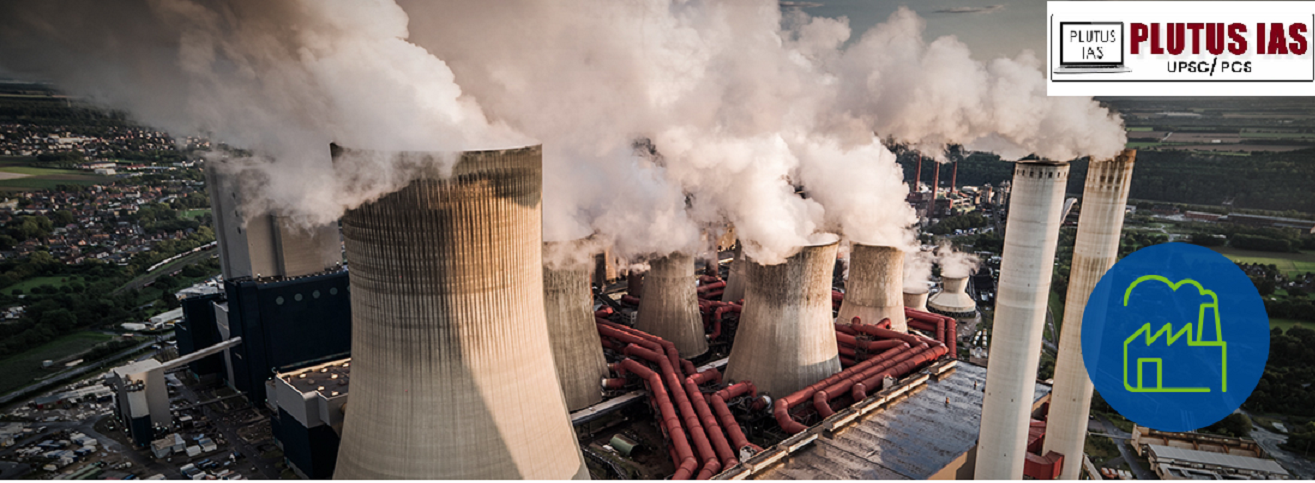02 Jan India’s Role in Global Greenhouse Gas Emission Reduction Efforts
SYLLABUS MAPPING:
GS-2-Environment-India’s Role in Global Greenhouse Gas Emission Reduction Efforts
FOR PRELIMS:
What greenhouse gas effect and India’s national mission on climate change
FOR MAINS
Reason for India’s greenhouse gasses reduction challenges associated with GHG reduction and sustainable practises to achieve net zero emission by 2070
Why in the news?
What is greenhouse gas?
A greenhouse gas (GHG) is a gas in the Earth’s atmosphere that traps heat, contributing to the greenhouse effect, which keeps the planet warm enough to support life. These gases absorb infrared radiation (heat) emitted from the Earth’s surface and re-radiate it back, preventing it from escaping into space. This natural process helps maintain temperatures that are conducive to life on Earth.
Key achievements:
1. Global Emissions Decline (2020): 7.6% drop in global GHG emissions due to COVID-19. 2.4 billion tons reduction in CO2 emissions.
2. India’s Emission Intensity: 36% decrease in GDP emission intensity (2005-2020). 7.93% reduction in national emissions in 2020.
3. Global Carbon Intensity: 40% reduction in carbon intensity (1990-2020), showing economic decoupling from emissions.
4. Renewable Energy Growth: Global renewable capacity surpassed 2,800 GW (29% of global electricity). Solar power capacity reached 1,000 GW by 2023.
5. Methane Emissions: Over 100 countries pledged to reduce methane emissions by 30% by 2030.
6. Carbon Capture & Storage (CCS): 30+ large-scale CCS projects capture 40 million tons of CO2 annually.
7. International Climate Agreements: The Paris Agreement (2015) aims to limit warming to 1.5°C. 130 countries committed to net-zero emissions by 2050.
8. Ozone-Depleting Substances: The Montreal Protocol reduced the use of harmful chemicals by 99%.
Steps were taken to reduce GHG:
1. Use Renewable Energy: Switch to renewable energy sources like solar, wind, and hydroelectric power to reduce reliance on fossil fuels.
2. Reduce Energy Use: Lower energy consumption by using energy-efficient appliances, turning off lights, adjusting heating and cooling, and using less hot water.
3. Reduce Transportation Emissions: Walk, bike, use public transportation, or drive less. Opt for fuel-efficient or electric vehicles.
4. Reduce Waste: Recycle, reuse, repair, and minimize waste generation to lower emissions associated with landfills.
5. Eat Less Meat: Reducing meat consumption, especially red meat, can lower methane emissions from livestock and reduce your carbon footprint.
6. Use Carbon Capture and Storage (CCS): Implement CCS technology to capture and store CO2 emissions from power plants and industrial activities.
7. Use Energy-Efficient Products: Invest in energy-efficient products, such as LED bulbs, efficient appliances, and home insulation, to reduce energy consumption.
8. Plant a Tree: Planting trees helps absorb CO2 from the atmosphere, reducing overall GHG emissions.
Still, a long way to go:
1. Global Emissions Continue to Rise: Despite efforts, global emissions have continued to rise, with countries like China and India seeing increased emissions due to rapid industrialization and growing energy demands.
2. Insufficient Renewable Energy Transition: Renewable energy adoption is growing, but fossil fuels still account for a large portion of global energy consumption. A faster transition to solar, wind, and other renewable sources is essential.
3. Unprecedented Emissions from Transportation: The transportation sector remains one of the largest sources of emissions, with many countries still heavily reliant on gasoline and diesel vehicles. Transitioning to electric vehicles (EVs) needs to accelerate.
4. Deforestation and Land Use: Deforestation continues at alarming rates, particularly in the Amazon and Southeast Asia. This reduces the planet’s ability to absorb CO2 and disrupts ecosystems.
5. Inequitable Climate Actions: Many developing nations face challenges in adopting cleaner technologies due to financial and infrastructural limitations. Climate change impacts disproportionately affect these regions, often making it harder for them to invest in mitigation strategies.
6. Carbon Capture Technology Limitations: While carbon capture and storage (CCS) holds promise, it is still in the early stages and faces technical, economic, and environmental hurdles.
7. Political and Economic Barriers: Despite international agreements like the Paris Agreement, political will to implement policies for reducing emissions can be inconsistent.
Way to achieve net zero in 2070:
1. Decarbonize Energy: Shift to renewables (solar, wind, hydro). Invest in energy storage and nuclear power.
2. Electrify Transport: Promote electric vehicles (EVs) and build charging infrastructure. Electrify public transportation and use alternative fuels for aviation and shipping.
3. Improve Energy Efficiency: Enforce energy efficiency in buildings and industry. Promote circular economy practices.
4. Carbon Capture & Removal: Scale up CCS and direct air capture technologies. Invest in afforestation and soil carbon sequestration.
5. Sustainable Agriculture: Reduce methane emissions from farming. Promote plant-based diets and regenerative farming.
6. Green Finance & Incentives: Implement carbon pricing and invest in clean technologies.
7. Global Collaboration: Strengthen climate agreements and facilitate technology transfer to developing countries.
8. Education & Public Awareness: Increase climate education and promote sustainable lifestyles.
Conclusion
Q. Which of the following is true regarding India’s greenhouse gas emissions and climate goals?
1. India reduced its greenhouse gas emissions by 7.93% in 2020.
2. India aims to achieve net-zero emissions by 2050.
3. India’s GDP emission intensity decreased by 36% between 2005 and 2020.
Select the correct answer using the code below:
A. 1 and 3 only
B. 2 and 3 only
C. 1, 2, and 3
D. 1 only
Answer: A
Mains Question:
(250 words, 15 marks)





No Comments